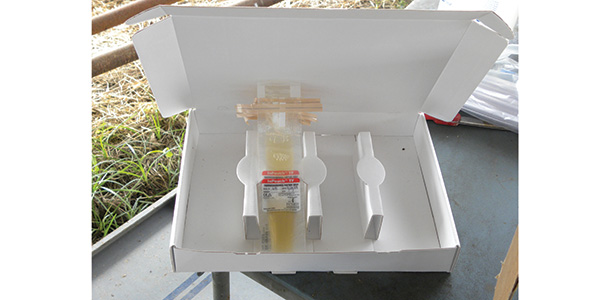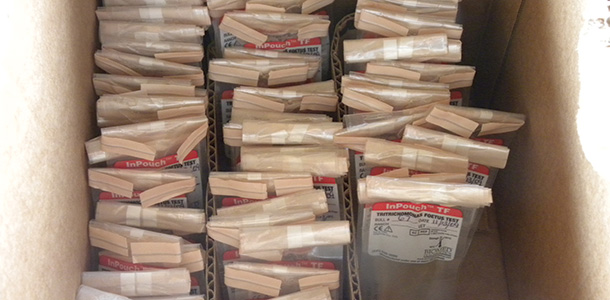The first thing a producer might see are cows returning to heat when they should be pregnant. This sexually transmitted disease is caused by protozoa that inhabit the reproductive tract of cows and the sheath of bulls.
It crops up most often when ranchers use untested bulls, purchase open cows with unknown background or when cattle herds commingle.
Trich has been a problem for many years in Western states, and most states have taken steps to try to control it with import regulations and testing. Idaho was the first to require mandatory annual testing of bulls, beginning in 1989.

Testing strategies
Dr. Debra Lawrence, Idaho state veterinary medical officer, says that for a while the only way to check for trich was to take a sample from the bull’s sheath and culture it.
This gives a 90 percent chance of finding it if the bull is infected. Standard practice is three cultures, a week apart. If they all come up negative, there is only one chance in 1,000 that the bull is infected.
Today, however, many breeders choose to use a PCR test, which is more accurate and faster.
“It is becoming more affordable, and we can do it in our Boise lab,” says Lawrence. “We are now doing a lot more PCR tests, which speeds things up, especially if a producer wants to turn out soon. He doesn’t have to wait so many weeks for test results.
“We still encourage ranchers who will be turning out on grazing allotments to start testing 45 days prior to turnout. Even though PCR tests don’t take as long, they have to be a week apart.
Ranchers have to make sure every bull is clean before they turn out.”
“The newest, greatest news is that this past year we only had five positive bulls in Idaho – three beef bulls from one herd, one from another herd and one dairy bull. This was a huge improvement from the numbers we’ve had in the past,” says Lawrence.
Even though a single PCR test is very accurate, Idaho regulations still require that any non-virgin bull coming into the state from an unknown background must have three tests a week apart. Idaho requires three negative tests, whether they are PCR or a culture.
“Imported bulls must be under 12 months old to be considered virgins. Native Idaho bulls may still be considered virgins at 24 months if they have never been with females since weaning,” says Lawrence.
“Some states accept pooled samples. If ranchers have five bulls, they can put those samples all together for the PCR test,” she says. If the test comes back negative, all the bulls are OK and it saves money on testing.
But if the pooled sample comes back positive, they have to go back and test each bull. Idaho does not accept pooled samples.
Most Western states now require an annual test before a bull can be put with cows. “Just about any state where Idaho ranchers send bulls with cattle to graze requires tests. Our field veterinarians are stepping up surveillance of bulls, especially in state border areas, to make sure we keep up the improvement in halting this disease,” says Lawrence.
Pushing for compliance
Dr. Jim Logan, Wyoming state veterinarian, says that when he began his job in 1998, Wyoming didn’t have any rules for trich.
“There were a few times in the 1980s when the Livestock Board implemented test requirements on six counties in western Wyoming, where all bulls had to be tested.
“After that was dropped, we didn’t have any requirements for testing. In early 1998, cattle producers came to me with major concerns about trich.
In 2000 the Livestock Board established the first statewide rules for trich in Wyoming. Since then, those rules have undergone several revisions,” he says.
“We can’t seem to eradicate this disease. In spite of the fact that most Western states now have rules and requirements for testing, trich continues to show up.
Most states have rules that require testing of bulls prior to sale, and if infection is found in a herd there are quarantines – always the bulls, but in some cases the cows are also quarantined. In spite of this, the disease continues to raise its ugly head,” says Logan.
“We can make good rules, based on science, that look good on paper. But until the entire industry steps up and complies, it will be very difficult to get rid of trich,” he says.
In spite of rules, some stockmen don’t test their bulls and some purchase cattle with unknown history. This puts their neighbors’ herds at risk if cattle mingle on public range or a bull goes through a fence to breed the neighbor’s cow – or an infected cow gets into the neighbor’s place and is bred by the neighbor’s bull, and that bull becomes infected.
“Part of the problem is that we don’t have a good test for females,” says Logan. “A small percentage of females can act as carriers without showing any signs of the disease.”
Logan says open females and cows that calve late in a herd should be culled. When trich enters a herd, its typical to see more cows open in the fall or cows that lost an early pregnancy and re-bred for a late calf.
“Mandatory testing of bulls and sale of open cows for slaughter is probably the only way we can control this disease, but this becomes a property rights issue,” Logan says.
“I am a proponent of private property rights, but trich complicates things. When should state rules override private property rights? Should the state be able to tell someone they have to sell all their open cows? This is probably not the best thing to do, but this is where it goes back to the industry’s responsibility.
“We need to use common sense and not take risks. But we know those risks will continue to be taken.”
If a rancher puts neighbors’ cattle at risk by not testing bulls or not selling open cows, or by bringing in open cows from somewhere else (that might be infected), this becomes a concern that must be addressed. This is the reason states have stepped in and demanded testing.
“A year ago the Wyoming Legislature passed a law stating that if a producer is aware of or should have been aware of a financially significant disease in their herd (cattle, sheep or other livestock) and did not test, or turned out animals without following state regulations, it puts them at some liability.
The diseases this rule applies to must be designated by the Livestock Board. Currently trichomoniasis and brucellosis are the only two diseases in this designation,” says Logan.

Collaborative rule-making
Efforts have grown among the 18 Western states to harmonize import requirements for trich when cattle move between states, a promising development considering the historical varying rules between states.
“We are not completely synchronized yet, but we have made some progress in getting more consistency,” Logan says. “It’s hard for producers and veterinarians when animals going to state A need one thing – and when going to state B need something completely different to comply with import rules.
Each state has to be able to decide what it needs to do to protect itself, but effort is under way to have the rules more similar. We will be talking about this at the Western States Livestock Health Association meeting in July.”
“The Institute of Animal Agriculture meeting (late March-early April, in Omaha) will also be looking at trich, the science and research, and trying to better harmonize the rules between states,” says Logan.
His advice to producers is to follow the recommendations and rules. “You could easily have trich in your herd and not be aware of it.
There’s not always a sudden drastic reduction in pregnancy rates. Annual testing of bulls is important, along with sending open cows to slaughter only – so they won’t end up in someone else’s herd,” he says. ![]()
PHOTOS
PHOTO 1: Samples are collected beside a chute on bulls with a PCR test.
PHOTO 2: This sample of pouches will be sent to a PCR test site with results sent in much faster times than previous culture tests.
PHOTO 3: A box of samples testing for trichomoniasis. Photos courtesy Dr. Tom Hairgrove.








